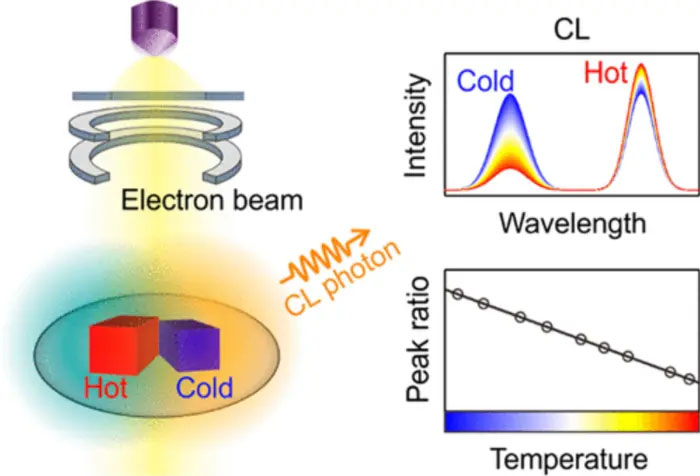| Mar 07, 2024 |
|
(Nanowerk News) A groundbreaking method for measuring the temperature of nanometer-sized samples within a transmission electron microscope (TEM) has been developed by Professor Oh-Hoon Kwon and his research team in the Department of Chemistry at UNIST. This innovative technology, utilizing nano-thermometers based on cathodoluminescence (CL) spectroscopy, opens up new possibilities for analyzing the thermodynamic properties of fine samples and advancing the development of high-tech materials.
|
|
The findings of this research have been published in ACS Nano (“Nanoscale Cathodoluminescence Thermometry with a Lanthanide-Doped Heavy-Metal Oxide in Transmission Electron Microscopy”).
|
 |
| Schematic illustration of the cathodoluminescence (CL) nanothermometry. (Image: UNIST)
|
|
The transmission electron microscope allows researchers to observe samples at a magnification of hundreds of thousands of times by transmitting a short-wavelength electron beam through the sample. By detecting light emitted from the sample through cathode ray emission spectroscopy, researchers can finely analyze the physical and optical properties of the sample at nanometer scales.
|
|
The newly developed nano-thermometers rely on the temperature-dependent intensity variation of a specific cathode ray emission band of europium ions (Eu3+). By synthesizing nanoparticles doped with europium ions within gadolinium oxide (Gd2O3), the research team ensured minimal damage from the electron beam, enabling long-term experiments.
|
|
Through dynamic analysis, the team confirmed that the intensity ratio of the light emitting band from europium ions is a reliable indicator of temperature, with an impressive measurement error of about 4 °C using nano thermometer particles measuring approximately 100 nanometers in size. This method offers more than twice the accuracy of conventional TEM temperature measurement techniques and significantly improves spatial resolution.
|
|
Furthermore, the team demonstrated the applicability of the nano-thermometers by inducing temperature changes with a laser within the TEM and simultaneously measuring temperature and structural variations in real-time. This capability allows for the analysis of thermodynamic properties at the nanometer level in response to external stimuli, without interfering with standard TEM analysis procedures.
|
|
Won-Woo Park, the first author of the study, emphasized the non-invasive nature of the temperature measurement process, highlighting that the interaction between the transmission electron beam and the nano-thermometer particles enables real-time temperature detection without disrupting TEM imaging. He noted, “The big advantage of the developed nanometer is that the temperature measurement process does not interfere with the existing transmission electron microscope analysis,” adding, “Since temperature is measured using light, a by-product generated by the interaction between the transmission electron beam and the nanometer particle, it is possible to measure the image of the transmission electron microscope and detect the temperature in real time.”
|
|
Professor Kwon underscored the significance of this research, stating that “The developed temperature measurement indicators, when combined with real-time imaging techniques, facilitate the observation of local temperature changes in response to external stimuli.” He further stated, “This advancement is poised to significantly contribute to the development of high-tech materials such as secondary batteries and displays.”
|
- SEO Powered Content & PR Distribution. Get Amplified Today.
- PlatoData.Network Vertical Generative Ai. Empower Yourself. Access Here.
- PlatoAiStream. Web3 Intelligence. Knowledge Amplified. Access Here.
- PlatoESG. Carbon, CleanTech, Energy, Environment, Solar, Waste Management. Access Here.
- PlatoHealth. Biotech and Clinical Trials Intelligence. Access Here.
- Source: https://www.nanowerk.com/nanotechnology-news3/newsid=64811.php




